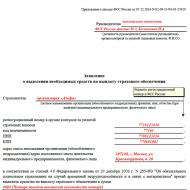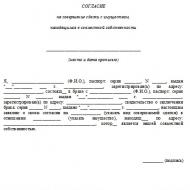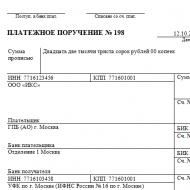
Rules for keeping score 62 on a common system. The need for subaccounts in wholesale trade. Which accounts does it correspond with?
In accounting, account 62 is used to control this register. analytical accounting for all documentation presented to the customer, as well as for monitoring incoming payments.
An accountant working with account 62 reflects as completely as possible all data about the buyer in the register. This approach allows you to quickly analyze:
- terms of payment under the contract;
- control overdue payments on issued certificates;
- accumulate advances received towards future services;
- keep track of bills that are not due for payment;
- control overdue bill receipts.
There is no provision for dividing account 62 into subaccounts in the chart of accounts, so the accountant independently applies analytics that are convenient for a particular organization. This division is necessarily reflected in accounting policy companies.
Retail can use account. 62 without analytics
Maintaining 62 accounts without breaking them down into subaccounts is convenient for companies engaged in retail trade and receiving payment for the goods in cash through cash machine. In retail, they are not interested in the buyer’s data and do not draw up long-term contracts with him. Most often, all buyers end up in a single sub-account called “Private Individual”.
Retail companies engaged in selling things in installments, on terms of lending to citizens (not banks), often face the problem of difficult tracking of loan repayments. Chain stores that sell expensive household appliances mainly find themselves in this situation. There is also a need for tracking in case of prepayment for goods. Therefore, it would be more appropriate to maintain sub-accounts for such clients.
It is worth noting that maintaining an account linked to certain sellers or managers can help in the fight against theft and monitor the correct execution of the order. The score will clearly demonstrate what material person made a miscalculation when shipping or paying for the goods.
The need for subaccounts in wholesale trade

In wholesale and non-cash trade the situation is different. 62 the account is maintained for each counterparty agreement. This is especially important when customers enter into several contracts with different conditions and terms.
Using subaccounts results in rather labor-intensive accounting. 62 account is overgrown with nomenclature, but such work is justified, as it makes accounting convenient and reliable. Such reporting is also convenient in case tax authorities have questions. Maximum transparency of calculations is always encouraged.
Account 62: postings
All fulfilled obligations with clients are always debited to sales accounts 90.1) and credited in correspondence with cash receipts(dt 51 set 62.1). Such postings are basic. The amounts of advances received are accounted for in separate sub-accounts (kt 51, kt 62.2).
If the calculation is ensured by an interest-bearing bill, then as payments are received it is debited and the interest goes to other income and expenses (account 91).
Using 62 accounts when working with branches

In the event that an organization has separate units and draws up a consolidated balance sheet, Accounting settlements and obligations with customers and purchasers are carried out separately.
If the parent organization carries out all payments for it, then invoices must be used in the transactions. 79. For example, cash for the sale of goods and services are debited to the “Internal business settlements” account, and credited to account 62 (dt 79, set 62). Branches are also required to introduce subaccounts similar to the parent company for more convenient balance consolidation.
For more detailed coverage of the features of accounting for settlements with buyers and customers, you must refer to the Instructions for using the Chart of Accounts.
Account 62 in accounting is usually debited for the amounts of payment documents presented in correspondence with the credit of accounts 90 “Sales”, 91 “Other income and expenses”, and credited for the amount of payment received in the debit of accounts 50 “Cash”, 51 “ Current accounts" and etc.
Analytical accounting for account 62 must be maintained for each invoice presented to customers, and when making payments using scheduled payments - for each buyer and customer. Analytical accounting of settlements with buyers and customers should be organized in such a way that it is possible to obtain data on settlements with such counterparties:
- according to payment documents for which the due date has not yet arrived;
- for settlement documents not paid on time;
- on advances received;
- on bills of exchange for which the due date for receipt of funds has not arrived;
- on bills discounted (discounted) in banks;
- on bills for which funds were not received on time.
Documentation of settlements with buyers and customers depends on the features and procedure for settlements with buyers, whether cash or non-cash payments are made to buyers. As a rule, such documents are invoices, acts, invoices, cash and sales receipts. For example, the rules for paying customers in cash, as a rule, require the issuance of only cash register receipts to them, and when making payments for delivered goods, organizations draw up delivery notes and, if the transaction is subject to VAT, invoices.
In the case of the creation of “doubtful” reserves, the debt of buyers in the balance sheet is reflected minus the created reserve (clause 35 of PBU 4/99).
However, it is impossible to answer unequivocally the question of whether settlements with buyers and customers are an asset or a liability. After all, according to settlements with buyers and customers, both accounts receivable (there is a shipment, but no payment) and accounts payable (when receiving advances) can be formed. In the first case, information on settlements with buyers and customers will be reflected in the balance sheet asset as part of accounts receivable, and in the second - in the passive as part short-term liabilities. This means that 62 counts accounting- This is an active-passive account.
IN modern conditions improving the accounting of settlements with buyers and customers comes down mainly to increasing the efficiency of data on settlements with buyers and speeding up the exchange of documents between counterparties. One of the elements in the development of the system of settlements with customers is the introduction of electronic document management.
Settlements with buyers and customers: postings
In settlements with customers, the main transactions consist of recognizing income from the sale of goods, works or services and receiving payments to repay accounts receivable, as well as advance receipts.
So, for the amounts of the presented settlement documents in the seller’s accounting records are made accounting records:
Debit account 62 - Credit account 90 “Sales”, 91 “Other income and expenses”The use of accounts 90 and 91 depends on whether the income being recognized is or.
IN retail sales the fact of sale can be recognized bypassing account 62 when a posting is made: Debit account 50 “Cash” - Credit account 90.
Accounting entries are created for the amounts of received payments (including advances):
Debit of accounts 50 “Cash”, 51 “Cash accounts”, 52 “Currency accounts”, etc. - Credit of account 62.
In this case, separate accounting of advances is kept on account 62, as a rule, by opening an additional sub-account.
In accounting for settlements with buyers and customers, postings are not limited to records for recording sales and receipt of payment. The procedure for accounting for settlements with buyers and customers requires reliable reflection of information about such settlements in financial statements. For these purposes, the debt of buyers and customers is analyzed for its doubtfulness and the need to create a reserve in account 63 “Provisions for doubtful debts” at the expense of financial results (clause 70 of Order of the Ministry of Finance dated July 29, 1998 No. 34n):
Debit account 91 “Other income and expenses” - Credit account 63.Account 62 in accounting accumulates data on settlements with buyers and customers. The features of its use are described in this article.
Accounting for accounts receivable on account 62
The rules that need to be kept in mind when working with account 62 “Settlements with buyers and customers” are indicated in the chart of accounts and instructions for it, approved by order of the Ministry of Finance of the Russian Federation dated October 31, 2000 No. 94n. Count 62 is used to reflect:
- accounts receivable (hereinafter referred to as receivables) of buyers and customers for goods, works, services sold (hereinafter referred to as GWS);
- accounts payable in the form of advances received.
Turnover in the debit of account 62 occurs when reflecting the debt of buyers when the sale of goods and services takes place. The second side of the posting will be income accounts 90.1, 91.1 or account 46 for the gradual reflection of income from long-term work. Thus, receivables are reflected simultaneously with revenue. In accordance with the accounting rules, revenue is shown in accounting if a number of conditions are met (clause 12 of PBU 9/99 “Income of the organization”, approved by order Ministry of Finance of Russia dated 05/06/1999 No. 32n):
- existence of a legally valid right to receive proceeds;
- availability of total revenue value;
- having confidence in receiving payment;
- a transfer of ownership was carried out, i.e. the buyer accepted the GWS;
- the presence of the total value of the corresponding expenses incurred to obtain this revenue.
If at least one condition is not met, then the payment received by the organization should be reflected as accounts payable, and not repay accounts receivable.
When payment is received from the buyer, account 62 is credited, and a debit entry is made in the cash accounts.
Analytics of 62 accounts should allow checking its balances for the presence of overdue debts, that is, carried out in the context of counterparties, issued invoices, and payment terms. To ensure transparency of reporting, overdue debt must be reserved by posting Dt 91.2 Kt 63 (clause 70 of the Regulations on accounting and financial reporting in the Russian Federation, approved by order of the Ministry of Finance of the Russian Federation dated July 29, 1998 No. 34n). In the balance sheet, receivables are shown minus reserves. Debts that cannot be returned and expired debts limitation period must be written off (clause 77 of the PBU) at the expense of the reserve by posting Dt 63 Kt 62, and if they were not reserved, then they are written off to financial results Dt 91.2 Kt 62. At the same time, for another 5 years, the written off debt is reflected on the balance sheet (account 007) in order to track changes in the financial condition of the debtor and the possibility of repaying the debt.
Accounting for advances received
Payment of goods and materials prior to their shipment or transfer is accounted for separately on account 62; subaccount 62.2 “Advances received” is usually used, while subaccount 62.1 “Settlements with buyers and customers” is used to account for receivables from buyers. In the balance sheet, advances received are included in accounts payable, that is, they are shown as a liability; it is impossible to show advances minimized from accounts payable. In addition, upon receipt of an advance payment, the supplier must charge VAT (clause 1 of Article 167 of the Tax Code of the Russian Federation).
Example:
In July, Pchelka LLC (buyer) and Vasilek LLC (seller) signed an agreement for the purchase of paving slabs worth RUB 944,590. In the same month, Pchelka LLC made a full prepayment. The following entries are made in the accounting of Vasilek LLC:
Dt 51 Kt 62.2 - 944,590 rub. - received to the bank account prepayment from Pchelka LLC;
Dt 76 subaccount “VAT on advances received” Kt 68 subaccount “VAT” 144,090 rub. (944,590 × 18/118) - VAT is charged upon receipt of an advance payment.
In August, Vasilek LLC shipped all paving slabs to the buyer and recorded the following entries:
Dt 62.1 Kt 90 — 1,944,590 rub. — revenue accrued;
Dt 90.3 Kt 68 subaccount “VAT” - 144,090 rubles. — VAT is charged on sales;
Dt 68 subaccount “VAT” Kt 76 subaccount “VAT on advances received” 144,090 rub. — previously accrued VAT on the prepayment received is accepted for deduction;
Dt 62.2 Kt 62.1 - 944,590 rub. — the previously received prepayment has been offset.
Payments by bill of exchange
The instructions for the chart of accounts also pay attention to the peculiarities of settlements with bills of exchange. If the buyer issues his own bill of exchange to the supplier, then the debt is not repaid, but by this action a deferred payment is issued and a guarantee of payment is issued. To account for bills received, it is recommended to allocate a separate sub-account, for example, 62.3 “Bills received”. The following entries are made in the seller's accounting:
Another situation arises if the debt is paid by a bill of exchange from third parties. Such a bill is recognized financial investment and is accounted for in account 58. In the supplier’s accounting, the entries shown in the table are made:
Results
For different types The chart of accounts provides for special accounts. One of them is account 62, which can be either active or passive, since it is used to account for both debt from buyers and customers, and creditors in the form of advances and prepayments received.
















